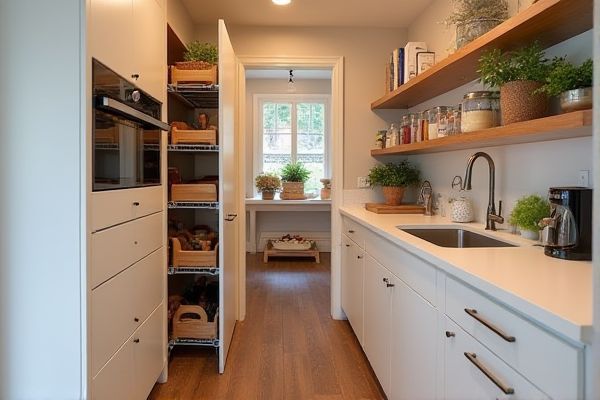
Vertical dividers in a pantry maximize storage efficiency by creating tall, narrow compartments perfect for organizing baking sheets, cutting boards, and trays, while horizontal dividers offer more flexible shelf space for stacking cans, jars, and boxes. Explore the rest of the article to discover which type best suits your pantry needs and enhances your kitchen organization.
Table of Comparison
| Aspect | Vertical Dividers (Pantry) | Horizontal Dividers (Pantry) |
|---|---|---|
| Purpose | Separates items side-by-side for better organization | Creates stacked layers for maximizing vertical space |
| Space Utilization | Optimizes width, ideal for tall items and trays | Optimizes height, suitable for flat or short items |
| Accessibility | Easy to grab items side-by-side without moving others | May require lifting or shifting items above |
| Installation | Usually fixed or removable panels | Often shelves or adjustable inserts |
| Common Use Cases | Organizing baking sheets, cutting boards, bottles | Stacking canned goods, boxes, or small containers |
| Materials | Wood, metal, plastic panels or rods | Wooden or metal shelves, plastic trays |
| Customization | Fixed width slots or adjustable dividers | Adjustable shelf heights or removable dividers |
| Visibility | Clear view of items side by side | Items may be hidden behind others stacked |
Introduction to Pantry Organization
Vertical dividers create accessible, space-efficient storage by allowing you to store large, flat items like cutting boards and baking sheets upright, preventing clutter and damage. Horizontal dividers facilitate stacking and separating items such as canned goods and boxes, optimizing pantry depth and visibility. Choosing the right divider type depends on your pantry layout and the variety of items you need to organize effectively.
What Are Vertical Dividers?
Vertical dividers in pantries are narrow, upright panels that separate items such as baking sheets, cutting boards, and trays, allowing for organized and space-efficient storage. These dividers help maximize vertical space by keeping items neatly upright and easily accessible, reducing clutter and preventing items from falling over. In contrast to horizontal dividers, which create stacked compartments, vertical dividers focus on optimizing the use of height for tall or flat kitchenware.
What Are Horizontal Dividers?
Horizontal dividers in a pantry are shelf inserts or panels that create layers within a cabinet, allowing you to stack items without them toppling over. These dividers maximize vertical space and improve organization by separating different categories of pantry goods or creating sections for trays and baking sheets. Your pantry becomes more accessible and clutter-free, enhancing storage efficiency.
Key Benefits of Vertical Dividers
Vertical dividers in pantries maximize storage efficiency by allowing easy access and clear visibility of stored items such as trays, baking sheets, and cutting boards. They help maintain organized vertical storage, reducing clutter and optimizing limited space for taller or thinner kitchen tools. This structure enhances pantry usability by preventing item stacking and promoting quick retrieval without disrupting other stored goods.
Major Advantages of Horizontal Dividers
Horizontal dividers in a pantry maximize storage by allowing you to stack items efficiently and keep products neatly organized without overcrowding. They provide easy access to frequently used items and create visually clear layers, making inventory management simpler. Your pantry benefits from improved space utilization and faster item retrieval compared to vertical dividers.
Best Use Cases for Vertical Dividers in Pantries
Vertical dividers in pantries are ideal for organizing cutting boards, baking sheets, and trays, maximizing space by storing items upright and easily accessible. They help maintain order by separating taller, flat items that can be difficult to stack horizontally without causing clutter. Your pantry efficiency improves significantly when vertical dividers are used to create dedicated slots for such items, preventing damage and streamlining retrieval.
Top Situations for Horizontal Dividers
Horizontal dividers in pantries are ideal for organizing items such as canned goods, spices, and small containers, allowing for easy visibility and access. These dividers maximize shelf space while preventing items from toppling over, making them perfect for stacked or grouped pantry supplies. Your pantry will benefit from horizontal dividers when you need efficient stacking and clear separation of frequently used ingredients.
Space Efficiency: Vertical vs Horizontal Dividers
Vertical dividers in pantry organization maximize space efficiency by utilizing the full height, allowing for the storage of taller items while keeping them accessible and neatly separated. Horizontal dividers create stackable layers, ideal for smaller or flat items but may limit visibility and quick access due to layering. Choosing vertical dividers enhances vertical storage capacity and ease of access, whereas horizontal dividers optimize horizontal space but can reduce overall storage flexibility.
Material and Installation Considerations
Vertical dividers in pantry design often utilize sturdy materials like wood, metal, or thick acrylic, chosen for their ability to support vertical weight and facilitate easy stacking of items, while horizontal dividers favor lightweight yet durable materials such as plastic, MDF, or thin plywood to maximize shelf space without adding excessive bulk. Installation of vertical dividers typically requires secure anchoring to the base or ceiling of the pantry to ensure stability under load, whereas horizontal dividers are usually installed between existing shelves or within drawers, demanding precise measurements and adjustable fittings for optimal spacing. Material selection for both types must account for moisture resistance and ease of cleaning, given pantry environments prone to humidity and food spills.
Choosing the Right Divider for Your Pantry Needs
Vertical dividers maximize space efficiency by allowing you to store taller items like baking sheets, cutting boards, or trays upright, making them easy to access and organize. Horizontal dividers work best for stacking smaller pantry items such as canned goods or boxes, helping maintain visibility and preventing items from toppling over. Understanding your pantry layout and the types of items you frequently store ensures you select the right divider to optimize functionality and maintain a clutter-free space.
 homyna.com
homyna.com